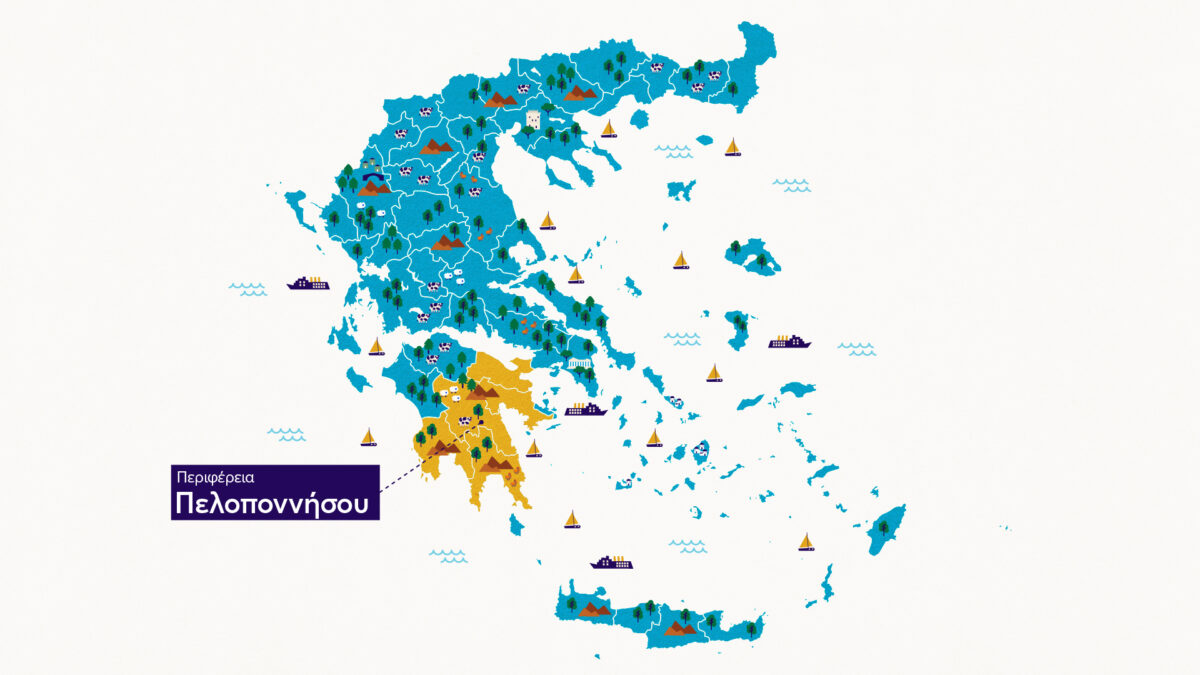The Region of the Peloponnese encompasses five Regional Units. They are Arcadia, Argolida, Korinthia, Lakonia and Messinia, with regional capitals at Tripoli, Nafplio, Corinth, Sparta and Kalamata, respectively.
The Peloponnese has figured prominently in Greek history since antiquity. The Mycenaean civilisation flourished here thousands of years ago, and many of the region’s cities figured prominently in classical history. Thanks to this, visitors interested in history and ancient cultures will find an impressive array of archaeological sites in the Peloponnese. Visitors are sure to be impressed by Mycenae, the ancient cities of Argos, Corinth, Nemea and Messini, the iconic theatre at Epidaurus, not to mention the imposing medieval fortresses of Mystras and Monemvasia, both in Lakonia.
The Peloponnese is also well known for its running waters: the region’s main river, and an ideal destination for rafting, is the Alfios. Also important is the river Evrotas, the delta of which forms a unique wetland habitat that has been included in the NATURA Network.
In addition to its rivers, the Peloponnese also has a number of picturesque lakes, such as lake Stymphalia, a striking wetland habitat, and the artificial lake Doxa, nestled within a captivating alpine environment on the Feneos plateau. Both are found in mountainous Korinthia and draw visitors year-round.
Another hallmark of the Peloponnese is its mountainous geography, with rugged natural beauty in abundance. Most prominent among its mountains is the famous Taygetos, which boasts one of Greece’s highest peaks at 2,407 metres above sea level. In addition, Parnonas and Mainalo, with its namesake ski resort, are also popular destinations for all manner of activities.
Visitors looking for a truly unique experience can go on a hike through the local gorges. The Lousios river Gorge, the Neda Gorge (which straddles the border of Messinia and Ilia) and the Rintomos Gorge in Messinia are all prime choices. Tourists interested in experiencing a geological marvel should visit the Diros Caves; this attraction is navigable by boat and features unique stalagmite and stalactite formations.
The Peloponnese coastline has no shortage of options for beachgoers. Prominent Messinian beaches include Voidokilia – a Natura 2000 Network locale – and the gulf of Kyparissia. Lakonia is home to Mavrovouni, Plytra and Marmari beaches. Easily accessible destinations with crystal-clear waters are Poulithra beach in Arcadia, Tolo beach in Argolida and Derveni beach in Korinthia. However, perhaps the most renowned and internationally recognisable beach is that of Simos on Elafonissos, with its golden sands and azure waters, which attracts hundreds of visitors from all over the world each summer.
Whether visiting stately, cosmopolitan Nafplio, historic Areopoli or Gytheio by the seaside in Lakonia, Stemnitsa and Dimitsana in Arcadia, Kardamyli in Messinia or Trikala in the mountains of Korinthia, tourists will have the opportunity to sample a true plethora of exceptional products and local dishes.
Olive oil is a vital local Peloponnesian agricultural product: some of the world’s top olive oils are produced in Lakonia and Messinia. In addition, thanks to their rich substrata and favourable climate, the farmlands of Argolida produce citrus and other fruits, as well as vegetables renowned for their quality and flavour. Locally produced crops include artichokes and prickly pears. Korinthia also produces another unique product: Corinth raisins. The Peloponnese also has a vibrant apiculture sector, producing exceptional honeys with varied flavour profiles thanks to its abundant natural wealth. Another major product of the Peloponnese is its wine: vineyards are cultivated throughout all regional units, and some of Greece’s best wineries can be found here.
Local Peloponnesian delicacies include a wide variety of dairy products – feta, graviera, myzithra, sfela and other cheeses – as well as cured meats and sausages. Also available are various local pies, such as saitia and travichtes, in addition to locally produced pasta such as goges and trahanas. Meals often feature dishes based on lamb or goat, with piglet also available as a local delicacy throughout the region.
And to start off the day, or even as a snack, visitors can sample some of the Peloponnese’s signature confections, such as sweet galatopita, tasty honey sesame bars (pasteli) and honeyed diples.










